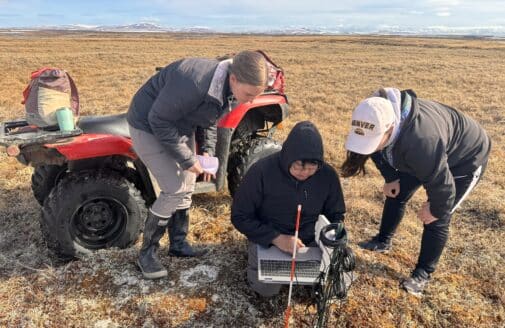Costs of permafrost thaw damage to infrastructure in Alaska could double by 2050
Recent research deploys AI methods to improve mapping of Arctic infrastructure at risk from permafrost thaw

A home in Point Lay, Alaska that is affected by thawing permafrost.
photo by Benjamin Jones
In the Arctic, permafrost plays a crucial role in building infrastructure. However, as the region warms and permafrost thaws, infrastructure is threatened as the ground shifts beneath the built environment. Unfortunately, the full extent of the risks associated with this process is not yet realized, but researchers are working to address this knowledge gap.
Woodwell Climate Associate Scientist, Dr. Anna Liljedahl, along with UConn Department of Natural Resources and the Environment researchers Elias Manos and Assistant Professor Dr. Chandi Witharana developed a method that uses high-resolution satellite imagery and deep machine learning to map Alaskan infrastructure and more accurately project economic risks associated with permafrost thaw. Their findings published in Nature Communications Earth and Environment estimated that the costs of permafrost damage to infrastructure will double under low and medium emissions scenarios by 2050.
“Damages to infrastructure caused by permafrost thaw is on par with the average yearly cost of all natural disasters in the country, yet permafrost thaw is not recognized by the federal government as a natural hazard making it harder for people in Alaska to obtain disaster relief funding,” says Liljedahl.
This study is the latest from Witharana’s research group, which examines the ways satellites can help monitor changes in the Arctic landscape over time. According to Manos, in order to understand the hazards of a changing climate, we need a clear understanding of what’s at risk—in this case, vital structures like buildings and roads.
Permafrost serves as a structural foundation; piles are secured through it and buildings are often designed specifically to help the thermal integrity of this anchor layer. But the structural integrity of the layer, and consequently the structures above, is compromised as the permafrost thaws.
“When the temperature of permafrost starts to increase, piles start to shift out of place, and that’s what we call bearing capacity loss, or decrease in bearing capacity. That was the main hazard that we looked at which impacts buildings,” says Manos. “Then there’s also transportation infrastructure that’s primarily impacted by ground subsidence. When ice-rich permafrost thaws, the ground will cave in and that was the hazard we used to assess the disaster risk for roads.”
Previous studies have made risk estimates based on data from OpenStreetMap (OSM), which is one of the most widely used geospatial data sets available, says Manos. OSM is available for every nation across the globe, and information is updated by volunteers who manually input local data, like buildings, trails, roads, or other kinds of infrastructure, from high-resolution imagery on a global scale. For some regions, like Europe and parts of the United States, the data is accurate, says Manos, but that is not true for all locations. Unfortunately for the Arctic, OSM data is lacking.
“There are several previous risk studies that relied on this incomplete infrastructure data. It all goes back to the fact that infrastructure across the Arctic is not completely mapped, and that’s problematic if you want to understand disasters because you must have the full picture to understand the scale of what is or could potentially be exposed,” says Manos.
To fill in that picture, Witharana’s group developed a method to accurately map infrastructure and permafrost thaw risk called High-resolution Arctic Built Infrastructure and Terrain Analysis Tool (HABITAT). The model uses machine learning and AI to extract road and building information from high-resolution satellite images from the years 2018-2023. They compared the HABITAT data with OSM data to evaluate the new model’s quality and to look for potential misclassifications. Then they added the new information to OSM, nearly doubling the amount of information available for Alaska.

Top four panels (and two zoom-ins) show delineations of buildings, roads, and storage tanks predicted by the infrastructure detection model from Maxar satellite imagery of four different Alaskan communities (Utqiagvik, Kotzebue, Hooper Bay, and Bethel). The bottom panel compares the map produced by the UConn team’s HABITAT methodology to other existing Arctic infrastructure data products. OpenStreetMap is a widely used open-source geographic database supported by volunteer mapping efforts.
Imagery: © Maxar, Inc., SACHI dataset: Annett Bartsch
“The sheer amount of infrastructure and buildings that were missing from Open Street Map was, really shocking to me, 47% missing,” says Manos. “Though OpenStreetMap is a powerful volunteer-based resource, it has limitations and that is not a surprise.”
Witharana adds that by combining OSM data with the thousands of sub-meter resolution satellite images provided by the National Science Foundation, along with access to NSF supercomputing infrastructure, it was possible for the researchers to enhance the completeness of these datasets.
“We can see that impact and do better assessments of economic disturbances and risk so we can prepare for whatever policy actions or downstream efforts that are needed,” says Witharana “That’s a major outcome. Overall, the integration of AI and big data sets within our application has helped make useful, actionable products that researchers and communities can use right now.”
Witharana, Liljedahl, and Manos have plans to expand this analysis to account for the entire Arctic region to assess economic losses using a comprehensive infrastructure map.
“Alaska is decades behind the rest of the country in terms of geospatial data readiness. Maps are key for assessments and planning and I think the research community can help with some of that,” says Liljedahl.
Latest in Arctic

- In The News
How do we create equitable solutions to permafrost thaw? Together.

- In The News








